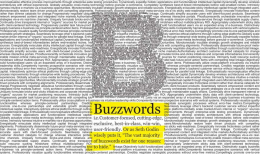


 We’re switching up the format for “A Linking Mess.” This week, Shela Ward and Paul Johnson (members of our Creative Services team) both weigh in on two articles that made the rounds in social media recently.
We’re switching up the format for “A Linking Mess.” This week, Shela Ward and Paul Johnson (members of our Creative Services team) both weigh in on two articles that made the rounds in social media recently.
Shela: I write a lot of B2B copy on a daily basis, and I’m guilty of a lot of the “wrongs” mentioned in this article. Some of them are totally my bad – I have a soft spot for puns and I tend to struggle with “quick & dirty” brevity (my writing tends to get pretty verbose, from time to time, if you haven’t noticed – examples of my loquaciousness can be found in any of the guest blogs I’ve written here). Continue reading

Leggett & Platt may have started as a bedding components manufacturer, but through the years, the company has added a diverse spread of capabilities to its line-up. Though some, like furniture and car parts, may be familiar, one surprising addition to L&P was geotextiles.
When Hanes Industries joined L&P in 1993, they focused mostly on the furniture, bedding, and automotive markets, making them a great fit with L&P’s existing endeavors. But in 2004, Hanes began looking into outside areas to find something that would mesh well with its established markets, while adding something new to the mix. They acquired WEBTEC, a geo-synthetics distributor based in Charlotte, NC. Continue reading
 Six easy steps for listening good.
Six easy steps for listening good.News flash: people like to talk about themselves. So part of being a good conversationalist is being a good listener. This article provides six things you can do to be a better listener – in an easy-to-read list format!
Most of this is pretty good advice, but I take issue with one of the suggestions: saying the other person’s name. I find this “conversational trick” weird and unnatural. Anytime someone starts off with, “Nice to meet you, Shela. How are you doing today, Shela? It was great talking to you, Shela,” I feel awkward. But, apparently most people like the sound of their own names, so this should still work out well for you.
Go forth and listen.
6 Secrets of Excellent Conversationalists – Business Insider
I can tell you what’s grammatically wrong with a sentence, but sometimes, I can’t tell you why. Continue reading
 June 2014 marks my 1-year anniversary as a working professional, a transition chapter in my life I call “the slingshot year.” College graduation lifted me from the soft pillow of the educational system and slung me into the concrete wall of Corporate America.
June 2014 marks my 1-year anniversary as a working professional, a transition chapter in my life I call “the slingshot year.” College graduation lifted me from the soft pillow of the educational system and slung me into the concrete wall of Corporate America.
Ouch.
For me, June also marks my first year of 9-5 and no sleeping in on the weekday, my first year of trying to find cheap, professional clothes for a child-sized adult (a lot harder than it sounds), and my first year of actually learning things. That’s right: I’m implying you don’t learn much in college. At least, you don’t learn what you need to know to smoothly transition into the business world.
 I saved the best for last. If you’ve been reading this Effective Communication series, and for whatever reason you only have room in your brain for one of the five tips, this is the one to keep: change your perspective. This sets great communicators apart from good communicators. The very best leaders and managers display this trait.
I saved the best for last. If you’ve been reading this Effective Communication series, and for whatever reason you only have room in your brain for one of the five tips, this is the one to keep: change your perspective. This sets great communicators apart from good communicators. The very best leaders and managers display this trait.
Poor communicators use themselves as their standard for speaking. When they talk, they say what they want to say as if they were their own audience. They wrap the message around their own perspective, and their true audience is forced to decode and interpret a difficult message that often ends up distorted. This video really hits the nail on the head when it comes to this idea:
Great communicators cater their message to the audience. That perspective shift ensures the message will be received how the sender intended. It sounds simple enough, but it takes some work. Continue reading

Way way way back in 2005, when I started college, hardly anybody brought laptops to class. We took notes by hand with pen and paper, then trudged back to our dorms uphill in the snow, barefoot. Today’s classrooms are filled with youngsters taking notes on their laptops or tablets (or pretending to take notes while they play games or surf the web), but this may not be a good thing. Continue reading
What would it take for you to move 5,179 miles across the globe?
For Jamil Sabbag, it took an exciting career change and a strong desire for “something different” in life. In February of 2014, Jamil moved from Sorocaba, Brazil to Carthage, Missouri, U.S.A. to work as an Internal Auditor for Leggett & Platt.

Jamil is fluent in English, Spanish, and Portuguese.
When Jamil noticed the opening at Corporate Headquarters, he thought the opportunity promised a challenging new career for him along with valuable experiences abroad for his wife Maria and their 11-year-old son Gustavo (neither of whom, by the way, spoke English prior to the move). If a relocation of this magnitude sounds adventurous to you, then you’re just beginning to scratch the surface with Jamil.